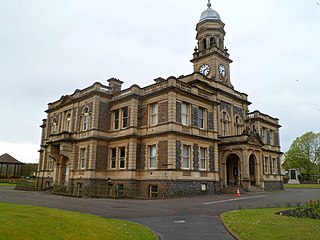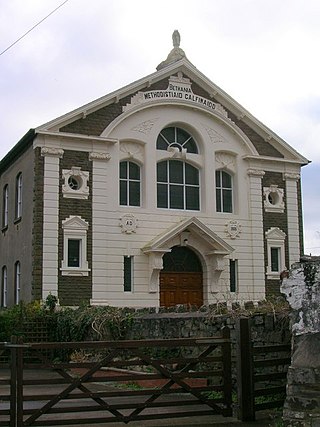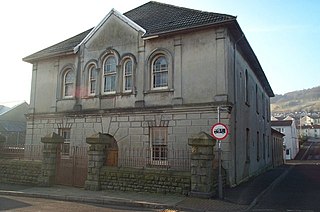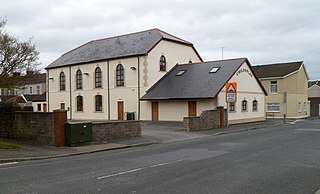
Llanelli is a market town and community in Carmarthenshire and the preserved county of Dyfed, Wales. It is located on the Loughor estuary and is the largest town in the county of Carmarthenshire.

Carmarthen is the county town of Carmarthenshire and a community in Wales, lying on the River Towy 8 miles (13 km) north of its estuary in Carmarthen Bay. The population was 14,185 in 2011, down from 15,854 in 2001, but gauged at 16,285 in 2019. It has a claim to be the oldest town in Wales – Old Carmarthen and New Carmarthen became one borough in 1546. It was the most populous borough in Wales in the 16th–18th centuries, described by William Camden as "chief citie of the country". Growth stagnated by the mid-19th century as new settlements developed in the South Wales Coalfield.

Glanamman is a mining village in the valley of the River Amman in Carmarthenshire, Wales. Glanamman has long been a stronghold of the Welsh language; village life is largely conducted in Welsh. Like the neighbouring village of Garnant it experienced a coal-mining boom in the 19th and early 20th centuries, but the last big colliery closed in 1947 and coal has been extracted fitfully since then.

Llangennech ( ) is a village and community in the area of Llanelli, Carmarthenshire, Wales, which covers an area of 1,222 hectares (4.72 sq mi).
This article is a timeline of Llanelli history. For a full article on the town, see Llanelli.

The Reverend David Rees was a Welsh Congregational minister of Capel Als chapel Llanelli, Carmarthenshire, and an editor of a radical Welsh language Nonconformist periodical titled Y Diwygiwr. Known as 'Y Cynhyrfwr', he held radical political views and opposed the relationship between the Established Church and the state.

Howell Elvet Lewis, widely known by his bardic name Elfed, was a Welsh Congregational minister, hymn-writer, and devotional poet, who served as Archdruid of the National Eisteddfod of Wales from 1924 to 1928.

Siloa Chapel was the largest of the Welsh Independent, or Congregationalist, chapels in Aberdare. Services are held in the Welsh language. Established in 1844, Siloa is one of the few Welsh-language chapels in the locality to remain open today. Siloa was notable for its long-serving ministers and in over a century there were only three pastorates, namely those of David Price (1843–1878), D. Silyn Evans (1880–1930) and R. Ifor Parry (1933–1964).

Saron was a Welsh Independent (Congregationalist) chapel in Davies Street, Aberaman, Wales, formed as an initiative of the David Price of Siloa, Aberdare, soon after the development of Aberaman as an industrial settlement as a result of the activities of Crawshay Bailey and David Davis, Blaengwawr. Saron was claimed to be the largest chapel in the Cynon Valley although Calvaria, Abercynon, Ebenezer, Trecynon and Siloa, Aberdare all had a similar capacity.

Capel Heol Awst is an Independent Welsh chapel in the town of Carmarthen, Carmarthenshire, Wales. The present building dates from 1826 to 1827, replacing a 1726 building which itself had been enlarged in 1802 and again in 1826 to seat a congregation of 1000. It is located on Lammas Street, Carmarthen. It was designated as a Grade II* listed building on 19 May 1981.

Capel Heol Dŵr was a Calvinistic Methodist chapel in the town of Carmarthen, Carmarthenshire, Wales. The building dates from 1831 and is located at Water St, Carmarthen. It was designated as a Grade II listed building on 19 May 1981.

Zion or Seion Baptist Chapel is a Baptist chapel in the town of Llanelli, Carmarthenshire, Wales. It was built in 1857 and is located at Island Place, close to the junction of Water Street with Upper Park Street.

Capel Als is an Independent (Congregational) chapel in Llanelli, Carmarthenshire, Wales, It is regarded as one of the most significant religious buildings in Wales. Folk tradition suggested that the name refers to a woman named Als, which along with Alys is the Welsh equivalent of the English name Alice, whose cottage stood where the chapel was built. Another theory contends that the Welsh word als translates as rock, and there is a rock-face behind the chapel. However, there is no word "als" in Welsh meaning rock, and so this latter explanation may be safely disregarded.

Thomas Johns was a Welsh Independent (Congregationalist) minister, best known for his pastorate at Capel Als, Llanelli, one of the largest chapels in Wales, from 1869 until his death in 1914.
Daniel John Davies was a Welsh Independent (Congregationalist) minister and Welsh language poet. He published under the name 'D.J. Davies' and was also well known as 'Davies Capel Als'.
Evan Gwyndaf Evans or "Gwyndaf" was a Welsh poet who served as Archdruid of the National Eisteddfod of Wales from 1966 to 1969.
Siloah was an Independent (Congregationalist) chapel in Copperworks Road, Seaside, Llanelli, Carmarthenshire. Services at Siloah were conducted in the Welsh language.

Soar Welsh Independent Chapel was an Independent (Congregationalist) chapel in Marsh Street, Llanelli, Carmarthenshire, Wales. Services at Soar were conducted in the Welsh language.

Ebenezer was an Independent (Congregationalist) chapel in Inkerman Street, Llanelli, Carmarthenshire, Wales. Services at Ebenezer were conducted in the Welsh language.
Lloyd Street, Llanelli was an Independent (Congregationalist) chapel in Lloyd Street, Llanelli, Carmarthenshire. Services at Lloyd Street were conducted in the Welsh language.
















